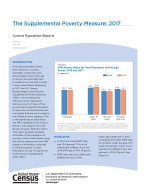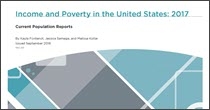The Supplemental Poverty Measure: 2017
The Supplemental Poverty Measure: 2017
Introduction
Since the publication of the first official U.S. poverty estimates, researchers and policymakers have continued to discuss the best approach to measure income and poverty in the United States. Beginning in 2011, the Census Bureau began publishing the Supplemental Poverty Measure (SPM), which extends the official poverty measure by taking account of many of the government programs designed to assist low-income families and individuals that are not included in the official poverty measure. This is the eighth report describing the SPM, released by the U.S. Census Bureau, with support from the Bureau of Labor Statistics (BLS). This report presents updated estimates of the prevalence of poverty in the United States using the official measure and the SPM based on information collected in 2018 and earlier Current Population Survey Annual Social and Economic Supplements (CPS ASEC).
Highlights
In 2017, the overall SPM rate was 13.9 percent. This is not statistically different from the 2016 SPM rate of 14.0 (Figure 1).
SPM rates were not statistically different for any of the major age categories in 2017 compared with 2016. SPM rates for children under age 18 were 15.6 percent, which is not significantly different than 15.2 percent in 2016 (Figure 1 and Figure 2).
The SPM rate for 2017 was 1.6 percentage points higher than the official poverty rate of 12.3 percent (Figure 3).
The percentage of individuals aged 65 and older with SPM resources below half their SPM threshold was 4.9 percent in 2017 (Figure 6).
There were 16 states plus the District of Columbia for which SPM rates were higher than official poverty rates, 18 states with lower rates, and 16 states for which the differences were not statistically significant (Figure 7).
Social Security continued to be the most important anti-poverty program, moving 27.0 million individuals out of poverty. Refundable tax credits moved 8.3 million people out of poverty (Figure 8).
Figures
Tables
Others in Series
Publication
Publication
Publication







